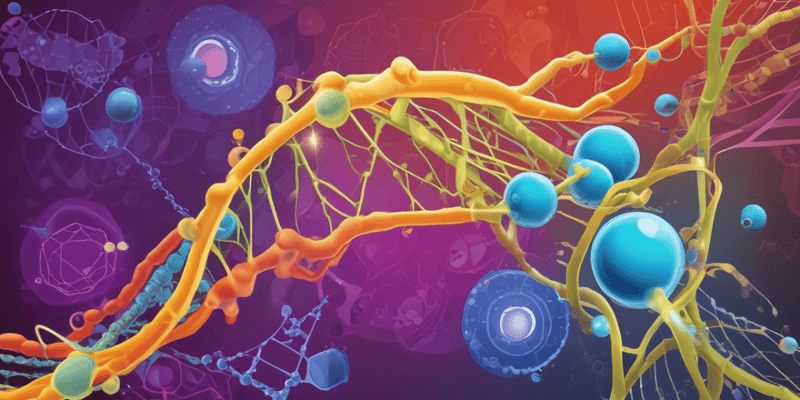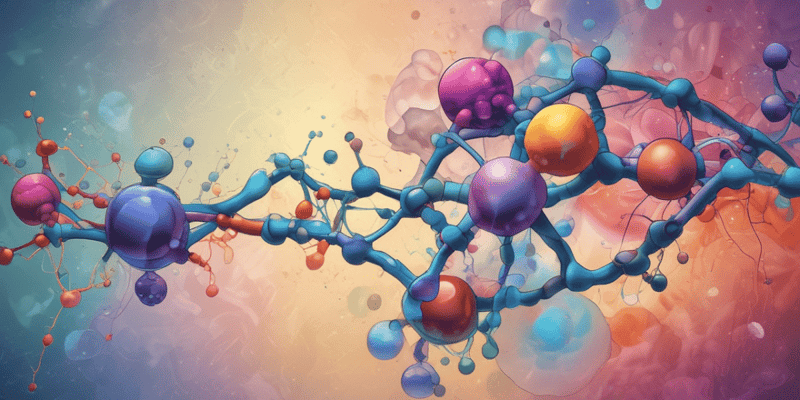20 Questions
Cells make two kinds of polynucleotides or nucleic acids: ______ and DNA.
RNA
DNA is a polymer of the four nucleotides A, C, G and ______ with the sugar deoxyribose.
T
RNA is a polymer of the four nucleotides A, C, G and ______ with the sugar ribose.
U
Nucleotides can be either ______ (A and G), which have a double ring base.
purines
The Watson-Crick Model of DNA has four main features: ______ with sugar-phosphate backbone outside.
Double helix
The Watson-Crick Model of DNA has four main features: Strict ______ of nucleotides (A:T; C:G).
base-pairing
DNA is copied using ______ replication - each parental strand from a double helix is used as a template to make a daughter strand along its entire length.
semi-conservative
This results in two double helices, each one having an “old” DNA strand paired with a “new” DNA ______.
strand
DNA replication involves a number of ______ that are required to unwind the double helix and make new, complementary strands.
proteins
Purines (A and G) have a ______ ring base.
double
Helicase breaks the ______ bonds between bases
hydrogen
Topoisomerase relieves the ______ caused by helicase
strain
Single Strand Binding Protein prevents DNA strands from ______ back together
winding
DNA polymerase III extends the 3' end of the ______ to make a new DNA strand
primer
DNA pol I removes the ______ primer and replaces it with DNA nucleotides
RNA
Ligase links two DNA fragments together with a ______ bond
covalent
DNA replication starts at an ______ of replication
origin
A replication bubble consists of two ______ that move away from each other in opposite directions
replication forks
Primase makes a short ______ primer to provide a pre-existing 3'-end
RNA
DNA polymerase 3 follows ______ and makes one long daughter strand on the leading strand
helicase
Study Notes
Molecular Composition of Nucleic Acids
- Nucleic acids are composed of two types: DNA (Deoxyribose Nucleic Acid) and RNA (Ribose Nucleic Acid)
- DNA is a polymer of four nucleotides: A, C, G, and T with sugar deoxyribose
- RNA is a polymer of four nucleotides: A, C, G, and U with sugar ribose
Nucleotide Structure
- Nucleotides can be classified into two types: purines and pyrimidines
- Purines (A and G) have a double ring base
- Pyrimidines (C, T, and U) have a single ring base
Watson-Crick Model of DNA
- Double helix structure with sugar-phosphate backbone outside
- Antiparallel strands held together by hydrogen bonding between bases
- Strict base-pairing of nucleotides: A:T and C:G
DNA Replication
- Semi-conservative replication: each parental strand serves as a template for a new daughter strand
- Two double helices are formed, each with an "old" DNA strand paired with a "new" DNA strand
- Process involves several proteins: helicase, topoisomerase, single strand binding protein, primase, DNA polymerase III, DNA pol I, and ligase
DNA Replication Proteins
- Helicase: breaks hydrogen bonds between bases, unwinding the double helix
- Topoisomerase: relieves strain caused by helicase, cutting and repairing the DNA
- Single Strand Binding Protein: prevents DNA strands from winding back together
- Primase: makes an RNA primer, providing a 3' end for DNA synthesis
- DNA polymerase III: extends the 3' end of the primer, making a new DNA strand
- DNA pol I: removes the RNA primer, replacing it with DNA nucleotides
- Ligase: links two DNA fragments together with a covalent bond
Replication Fork
- Origin of replication: where DNA strands are separated and replication begins
- Replication bubble: two replication forks moving away from each other, unwinding the parental DNA
- Helicase and topoisomerase work together to unwind the DNA, exposing new single-stranded DNA
Leading Strand Synthesis
- 3' end of the daughter DNA is towards the fork, allowing DNA polymerase III to synthesize a long, continuous strand
Lagging Strand Synthesis
- 3' end of the daughter DNA is away from the fork, resulting in the synthesis of short, discontinuous fragments
- Primase, DNA polymerase III, and DNA pol I work together to synthesize these fragments, which are later linked by ligase
Make Your Own Quizzes and Flashcards
Convert your notes into interactive study material.




